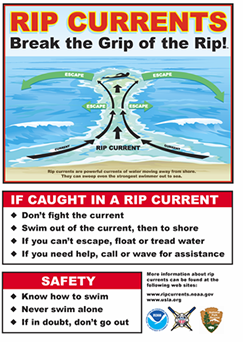 |
||||
| The Beach Beckons...but Rip/Longshore Currents Lurk Awareness Week Has Passed, but Safe Swimming is Year–Round! |
||||
|
While infrequent shark attacks along the Gulf and Atlantic beaches grab the headlines each summer, the more frequent, dangerous, and under reported killers are rip and alongshore currents. The United States Lifesaving Association estimates that every year more than 100 deaths occur by drowning at beaches due to rip or longshore currents. More than 80 percent of the rescues on these beaches performed by lifeguards are due to rip currents. Beaches along the Lower Texas Gulf coast are not immune to rip currents. Since June 2008, eighteen people have drowned at the beaches of South Padre Island and Boca Chica, mainly during the months of May, June, and July. This includes three recent unfortunate deaths, all occurring during the Memorial Day weekend of 2014. Sunny skies, warm air and water temperatures, and light to moderate surface winds can mask rip and longshore currents, which can occur under persistent easterly swell produced by broad high pressure ridges centered north of the border region, or by distant tropical, subtropical, or non tropical disturbances in the Gulf or Caribbean. When these conditions combine with swelled beach populations, such as United States Holidays including Memorial Day, the Fourth of July, and Labor Day, and other favored periods such as Semana Santa (Holy Week, including Good Friday and Easter Sunday) and the last two weeks in July (Mexico summer break), the potential for rip/longshore current danger increases. This is most critical for poor swimmers who venture a bit too far into the surf. Rip/Longshore current injuries and deaths are avoidable! Learning to swim, and knowing the threat for currents before you hit the surf, and understanding how to calmly escape the "grip of the rip" will ensure a safe and fun beach experience. The following pages and links that follow will help prepare you for this largely silent hazard. |
||||
|
|
||||
| Other Links
Safety Information
Daily Information
 |
||||